WORD PROCESSOR: HIGHLIGHTS FROM THE COLLECTION
December 9, 2013
Field Trip: The Plants of Virgil's Georgics
Rachael Wilson
I would sing:
in what way endive
and the shores brilliant green with celery
rejoice in river's streams,
and in the grass increased
the twisted cucumber for eating
—Georgics IV, trans. Chew
"But now is the time to gather acorns and laurel berries."
—Georgics I.305-306, trans. Hirtzel
fluminibus salices
"In rivers, willows" [Georgics II.110]
viminibus salices
"the withe-rich willows" [Georgics II.446]
et glaucus salices
"and pale-green willows" [Georgics IV.182]
In many respects, it is an unremarkable book: Lacking a dust jacket, the cover is a sun-bleached bluish-brown linen, and I can barely make out the worn silver lettering on the spine. Inside, tiffany blue endsheets cheer up appearances, while the inscription "2.00," meaning dollars, pencilled in the upper-right corner of the recto, brings it back down a notch. The unassuming book is Elfriede Abbe's The Plants of Virgil's Georgics, published by Cornell University Press in 1965. An immediate attraction of the book derives from the striking botanical illustrations—mainly woodcuts—that comprise about a third of the volume. Less apparent in its charms, but of no less interest after all, is the text.
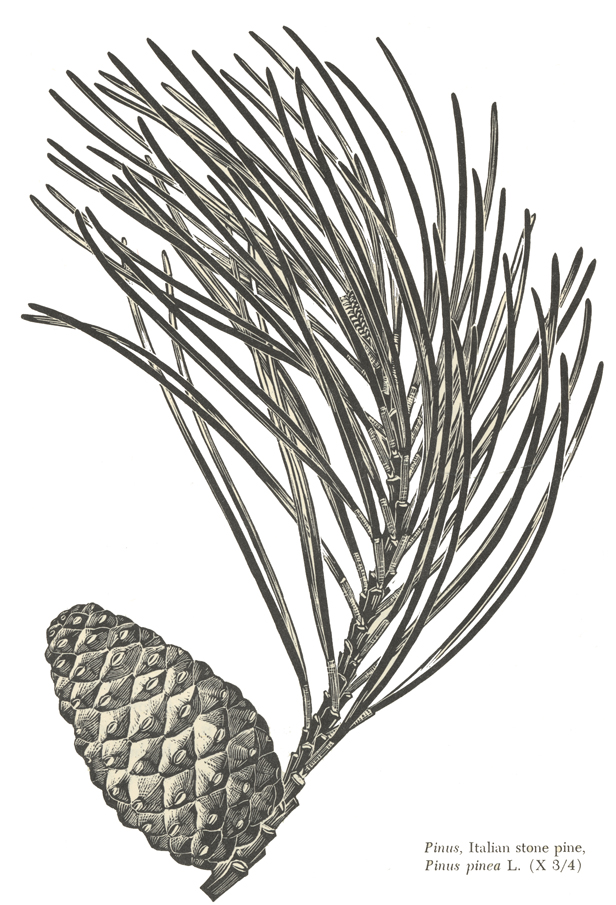
The Plants of Virgil's Georgics is basically what you would expect it to be: a catalogue of all the plant species that appear in the Roman poet's didactic poem on farming. The book is organized according to modern botanical classifications of "families," as Abbe puts it, "in so-called 'natural order,'" which is "a system of arrangement worked out by botanical authorities as a theoretical approximation of the evolutionary developments of the plant kingdom." So, beginning with the prehistoric fern family, Polypodiaceae, Abbe introduces Virgil's filix: common name "brake," or "bracken." Next follows taxus of the yew family, Taxacaea, then several species of pine and fir trees: spruce, juniper, cypress, and taeda, the "pitch-glutted wood"—not actually a species of tree, but any conifer affected with resinosis, "a disease, in which not only the heart but the outer part of the trunk becomes glutted with pitch."
Nearly every entry is accompanied by an illustration. Of these, all are woodcuts except for nine drawings, and all are "original renderings of live plants growing in Italy"—the results of field studies Abbe conducted for the book. The entries that head groupings of plant "families" open with a small line of type, justified right, which announces the family name. Thus, the first line of the entry for Far, common name farro, reads "Grass family, Gramineae," while the entries that follow in this section (milium, hordeum, triticum, avena, lolium, calamus and harundo, and ulva) omit this first line, beginning instead with the Latin species name center-justified in majuscule type.
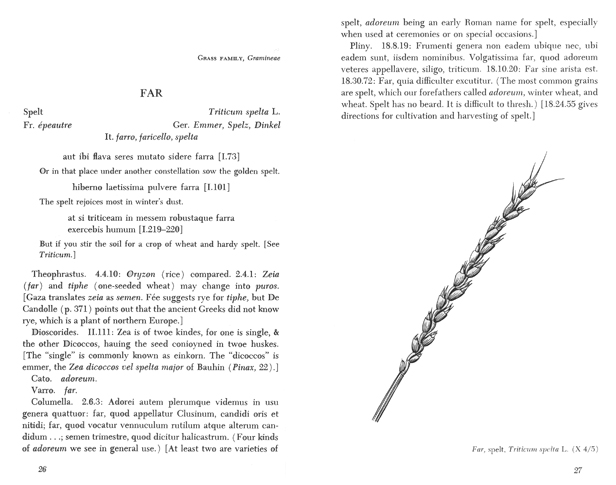
Following the species name, Abbe provides the common names in English, justified left, on a single line with the modern scientific name, genus and species, justified right. Below that follow the plant's common names in French, German, and Italian, while further down, we find the relevant quotations from the Georgics, accompanied by translations into English by Frederic Hirtzel. Finally, Abbe presents a miscellany of quotations from classical and medieval sources which aid in identifying the plant in question. Since Virgil's plants belong to the first century B.C.E., Abbe attempts to link the more than two-thousand-year-old vegetal referents with their modern counterparts by tracing botanical etymologies from the Classical period down to the present. She draws on ancient writers such as Theophrastus, Dioscorides, and Pliny; medieval and Renaissance scholars like Albertus Magnus, Apicius, Celsus, and St. Hildegard von Bingen; and modern botanists and Classicists from Karl Linnaeus to John Sargeaunt (author of The Trees, Shrubs, and Plants of Virgil). As Abbe writes, "The quotations from early works may interest the gardener, the seeker of herb lore, the student of botanical and horticultural literature and of the history of science, as well as the scholar of the classics." The quotations are often lyrical and humorous; they provide anecdotal information, folklore, and homeopathic tips, and they give texture to the book.
Under the entry for Taxus, for example, Virgil cautions "Let no yew grow near the houses of the bees," while Albertus Magnus informs that "Hens thrive on the seeds" of the yew. In the entry for Taeda, the "pitch-glutted wood," Dioscorides reports that a piece of taeda bark soaked in vinegar is good for a toothache. Opening to Cedrus, we find that "Apicius recommends juniper berries in meat sauces, with roast goat for example." While I was excited to learn of the existence of strawberry trees, from Pliny I discovered that "The strawberry fruit that grows on the ground is quite different from that of the strawberry tree... The fruit is not esteemed and is called unedo,[1] because after eating a single berry one has had enough." Elsewhere, Pliny tells how the Greeks call lappa (or goose grass) philanthropist (lover of mankind) "because it clings to one's clothes," and how the plant Narcissus isn't named for "the boy of legend" but comes from narke, meaning torpor, because "if taken internally in medicine... it makes the head feel heavy." It's also known as the "vomit bulb," bulbus vomitorius.
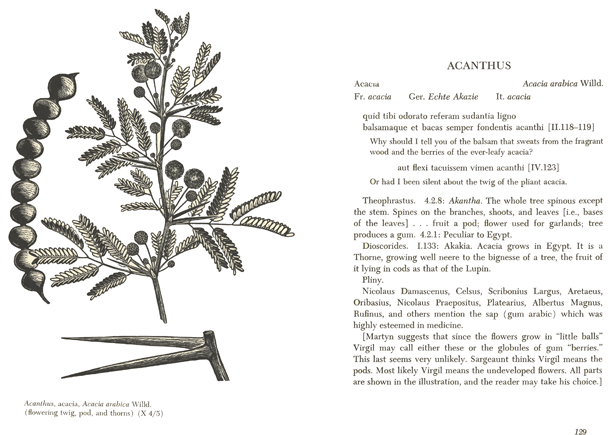
The overall look of the page in The Plants of Virgil's Georgics, with its broken lines of irregularly justified text, its font set variously in italics, or all caps, and in different weights and sizes, is dynamic. The graphic arrangement of the type imparts a sense of movement while maintaining an overall balance. In this respect, the typography complements the illustrations which appear, at once, boldly delineated in the style of woodcuts (with their heavy blacks and stark value contrasts) and also filled with a level of information—not ornate, but detailed—that seems at odds with the dramatic line. The typographic arrangements visually rhyme with the images, but they also call to mind the "look" of poetry: particularly, Modernist poetry and its successors.
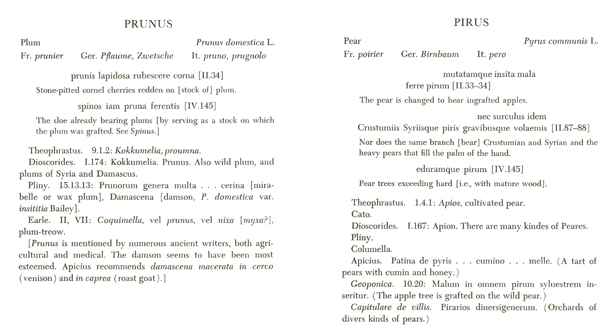
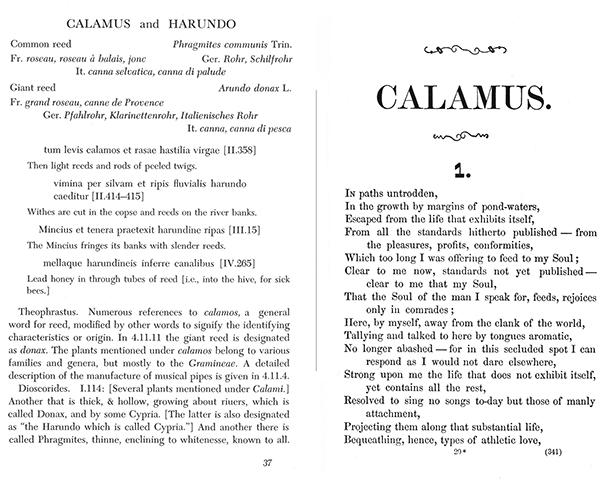
"Calamus and Harundo" from The Plants of Virgil's Georgics, left.
"Calamus" from Whitman's Leaves of Grass, right.
While reading The Plants of Virgil's Georgics, I had also picked up Kristina Chew's (self-professedly contemporary) translation of the Georgics. It paired well with Abbe's work. Whereas Virgil wrote his poem in line-after-visually-monotonous-line of hexameter (12 syllables), Chew's translation chopped up the lines and varied the rhythms, as in:
Roundabout
let there be green-glowing garlands
of Rose Daphne, the scent of Wild Thyme
all over, and a treasury of Savory
exhaling its perfume and flourishing,
and Violet Beds to sip refreshment
from the streams.
(from Book IV)
Clearly, Chew takes liberties with the poem, but the upshot of her translation is that it brings out the contemporaneity of Virgil's work: because, if hexameter is painfully outmoded, the conversational tone and mundane subject matter of Virgil's Georgics is entirely in keeping with much modern and contemporary poetry.
In the Georgics, Virgil creates a strange meeting of epic poem and farmer's almanac. He wasn't the first to do so (Hesiod's Works and Days preceded the Georgics by seven centuries), nor the last. Chew, for one, traces Virgil's influence on an emergent genre of "nature writing": as in Thoreau's journals, or John McPhee's The Pine Barrens. I see Virgil's influence, and particularly that of the Georgics, as branching in several directions. The Georgics is itself a mixture of epic and didactic poetry, and it blends pastoral lyric with long, plodding, descriptive passages. If the Georgics resurfaces in 19th and 20th Century "nature writing," it also finds contemporary expression in a poetics of "information" that has been gaining steam for the last half-century or so. I see Virgilian leanings of both sorts in Thoreau and McPhee, but also in Whitman's Leaves of Grass, Pound's Cantos, Williams' Paterson, in the poetry of Lorine Niedecker and, more recently, in works such as Alison Knowles' A Bean Concordance, or Robert Kroetsch's Seed Catalogue,[2] and in the work of Vito Acconci, Bernadette Mayer, Clark Coolidge, and others.
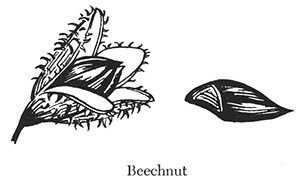
AGRICULTURAL METHODS AND TECHNIQUES
a significant number of these
once used long ago I am equipped
to tell if you should not think it
a waste of time to hear about something
of small consequence.
(from Book I, trans. Chew)
In The Plants of Virgil's Georgics Abbe creates a field guide to the fictive landscape of the poem. Abbe starts with one genre of information-writing—the didactic poem—and distills it into another: the field guide. In a way, she radicalizes Virgil's gesture, and her book comes closer to the spirit of contemporary poetry I described above than does the Georgics.
It is Abbe's literal-minded approach to the Georgics that resonates with contemporary aesthetics. When I first started thumbing through the book, I found myself uncertain of the author's background and unable to place the work. Was Abbe a classicist? She obviously read Latin (and French, German, and Italian) well enough to cull quotations from a number of sources and to translate them into English. The book was published by Cornell University Press, and Abbe did state in her introduction that she hoped the book would be "a useful contribution to Virgiliana." But what kind of a classicist also happened to be a gifted illustrator and printmaker? I thought Abbe was perhaps a botanist. A botanist would know Latin from her scientific studies, and a botanist could also be a trained draughtsman.
It turns out she was neither. Instead, Abbe was educated as an architect and a sculptor before she went on to take a job as an illustrator at Cornell, a position she held from 1942 until her retirement in 1974. While at Cornell, Abbe illustrated a number of books, such as Seven Irish Tales (1957), Emerson's The American Scholar (1955), The Significance of the Frontier in American History (1956), and Sedum of North America North of the Mexican Plateau (1975), but she produced nothing else quite like The Plants of Virgil's Georgics. Abbe also published books with the Southern Vermont Arts Center, and under her own imprint, the Press of Elfriede Abbe—books like Rip Van Winkle, Aesop's Fables, Elizabeth Barrett Browning's Prometheus Bound, Chaucer's The Canon's Yeoman's Tale, Hans Christian Anderson's The Wind's Tale, Eugéne-Emmanuel Viollet-le-Duc's The City of Carcassonne, and Shore Imprints: five wood engravings featuring coastal plants, The Fern Herbal: including the ferns, the horsetails, and the club mosses, and Mushrooms: wood engravings.
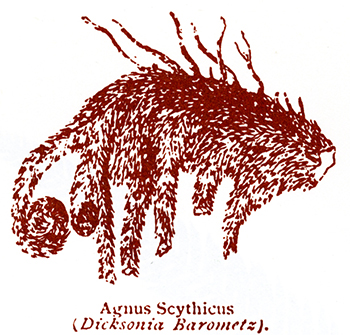
Cibotium barometz, Vegetable lamb, from The Fern Herbal.
"Virgil's Georgics first became known to me..." begins Elfriede Abbe's The Plants of Virgil's Georgics. Abbe closes the statement by relating how she came to the Georgics through a translation into English, before approaching the Latin text and later embarking on her project to catalogue and "illustrate" the poem's flora. Since it was Abbe's book that first prompted me to read the Georgics, I have the strange sensation of wanting to fold her opening sentence back on itself, completing it: "Virgil's Georgics first became known to me through Elfriede Abbe's The Plants of Virgil's Georgics." My experience of reading the Georgics was through the lens of Abbe's Plants. Her book emphasized something in the Georgics I might have missed otherwise, like a "soft tuft of the hyacinth," or "the small seeds of vetch."
At the end of her introduction, Abbe relates an anecdote about her travels in Italy while researching the book:
In the village of Bozzolo, halfway between Cremona and Mantua, the writer came upon a majestic Roman triumphal arch, its inscription weathered away and vegetation growing between the stones. It served as part stable, part storehouse, and the usual stacks of faggots and pole wood were stowed inside; but the aged village women who drew near to speak to me were proud of their porta romana and pleased that a stranger stopped to look at it.
Her story is clearly allegorical: an allegory of reading, and Abbe's invitation to the reader. The porta romana is the Georgics—but, here, where it serves as the scaffolding of her book, it has been humbled a little. It's still a beautiful piece of architecture, but it's also a practical place, a storage house for quotidian items, like bundles of wood.
Imagine this, then, to be the arch:
"molle siler lentae que genistae,
populus et glauca canentia fronde salicta" (Georgics II.12-13)
"the soft siler and the pliant broom,
the poplar and the hoary willow beds with whitening leaves"
The bundles are these: Celsus says that all parts of the willow have astringent properties and Pliny that "No matter how much it is trimmed, the willow continues to send out shoots." From Columella we learn that the poplar "makes the best vine support" and that the broom is good for weaving baskets. Siler, according to Theophrastus, may be used as a remedy for snake bite—useful knowledge, if it weren't for that siler, after all, is one of the few unidentified plants in the book: "probably one of the Umbelliferea," Abbe conjectures, "a number of herbaceous plants with woody stems." (Celery's named as an umbellifer).
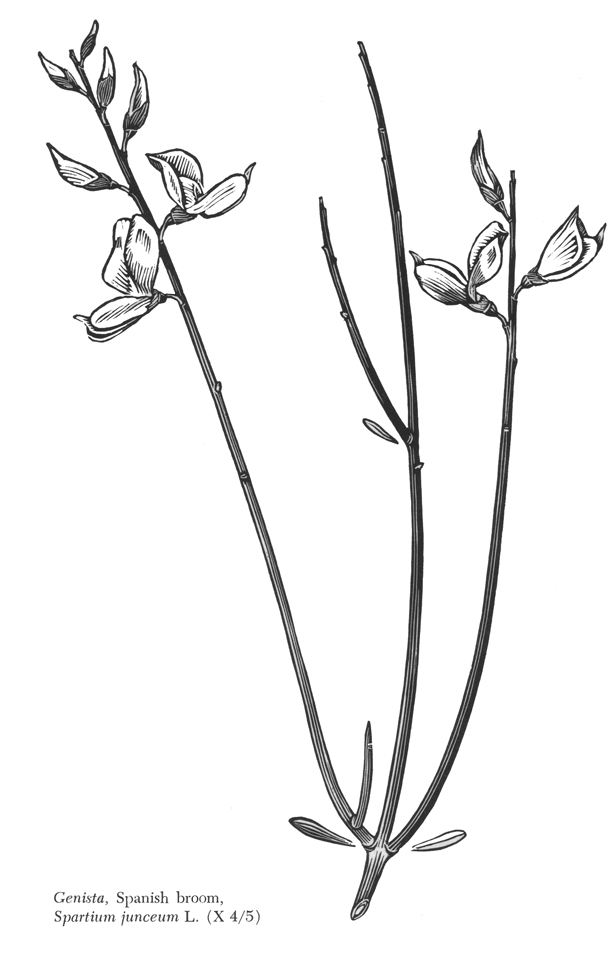
"Concerning fields, their care and cultivation,
The lives of herds, the needs of trees
I have sung—"
(from Book IV, trans. Chew)
Virgil ends his agricultural poem with an epic flourish. Abbe ends her field guide with a "List of Plants Giving Virgilian and Scientific Names" and a "Lists of Plants by English Common Names." While they're not exactly epic catalogues, they are catalogues, and they're useful—which was, after all, what Virgil's poem was supposed to be, too.
[1]From Pliny's description, I assume unedo translates as "one's enough," so that the strawberry tree fruit would be known in ancient Greek as a "one's-enough berry."
[2]A friend recently introduced me to the contemporary Canadian poet, Robert Kroetsch, whose long poems such as Seed Catalogue, and The Ledger, exemplify a strain of contemporary poetry whose deepest roots can be located in Virgil. Whereas Kroetsch's Seed Catalogue shares with the Georgics its characteristic mixture of an information-laden, prosaic style and a rural subject matter (I draw a further distinction between rural themes and the pastoral, which is romanticized rural subject matter), I want to stress that it's possible to isolate these two aspects of the poem, and that the "information-laden" side of the Georgics may resonate with contemporary writings devoid of rural subject, as in the poetry of Vito Acconci or Bern Porter.
![]()
Rachael Wilson is a Ph.D. candidate in English at New York University, where she works on post-war poetry and visual arts. She is a co-director of the Organism for Poetic Research and an editor of Pelt. Her work has recently appeared in Brooklyn Rail. She also co-authors an occasional arts anti-blog, Most Perfect World.
View The Plants of Virgil's Georgics in the catalog.
